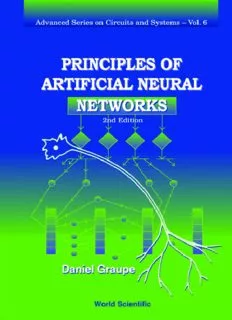Table Of ContentPRINCIPLES OF
ARTIFICIAL NEURAL
NETWORKS
2nd Edition
ADVANCED SERIES IN CIRCUITS AND SYSTEMS
Editor-in-Charge: Wai-Kai Chen (Univ. Illinois, Chicago, USA)
Associate Editor: Dieter A. Mlynski (Univ. Karlsruhe, Germany)
Published
Vol. 1: Interval Methods for Circuit Analysis
by L. V. Kolev
Vol. 2: Network Scattering Parameters
by R. Mavaddat
Vol. 3: Principles of Artificial Neural Networks
by D Graupe
Vol. 4: Computer-Aided Design of Communication Networks
by Y-S Zhu & W K Chen
Vol. 5: Feedback Networks: Theory & Circuit Applications
by J Choma & W K Chen
Vol. 6: Principles of Artificial Neural Networks (2nd Edition)
by D Graupe
Steven - Principles of Arti Neural.pmd 2 1/30/2007, 4:11 PM
Advanced Series on Circuits and Systems – Vol. 6
PRINCIPLES OF
ARTIFICIAL NEURAL
NETWORKS
2nd Edition
Daniel Graupe
University of lllinois, Chicago, USA
World Scientific
NEW JWRSEY . LONDON . SINGAPORE . BEIJING . SHANGHAI . HONG KONG . TAIPEI . CHENNAI
Published by
World Scientific Publishing Co. Pte. Ltd.
5 Toh Tuck Link, Singapore 596224
USA office: 27 Warren Street, Suite 401-402, Hackensack, NJ 07601
UK office: 57 Shelton Street, Covent Garden, London WC2H 9HE
British Library Cataloguing-in-Publication Data
A catalogue record for this book is available from the British Library.
PRINCIPLES OF ARTIFICIAL NEURAL NETWORKS (2nd Edition)
Advanced Series on Circuits and Systems – Vol. 6
Copyright © 2007 by World Scientific Publishing Co. Pte. Ltd.
All rights reserved. This book, or parts thereof, may not be reproduced in any form or by any means, electronic or
mechanical, including photocopying, recording or any information storage and retrieval system now known or to
be invented, without written permission from the Publisher.
For photocopying of material in this volume, please pay a copying fee through the Copyright Clearance Center,
Inc., 222 Rosewood Drive, Danvers, MA 01923, USA. In this case permission to photocopy is not required from
the publisher.
ISBN-13 978-981-270-624-9
ISBN-10 981-270-624-0
Printed in Singapore.
Steven - Principles of Arti Neural.pmd 1 1/30/2007, 4:11 PM
January30,2007 16:24 WorldScienti(cid:12)cBook-9.75inx6.5in ws-book975x65
Dedicated to the memory of my parents,
to my wife Dalia,
to our children, our daughters-in-law and our grandchildren
It is also dedicated to the memory of Dr. Kate H Kohn
v
TThhiiss ppaaggee iinntteennttiioonnaallllyy lleefftt bbllaannkk
January30,2007 16:24 WorldScienti(cid:12)cBook-9.75inx6.5in ws-book975x65
Acknowledgments
I am most thankful to Hubert Kordylewski of the Department of Electrical
Engineering and Computer Science of the University of Illinois at Chicago for his
help towards the development of LAMSTAR network of Chapter 13 of this text.
I am grateful to several students who attended my classes on Neural Network at
the Department of Electrical Engineering and Computer Science of the University
of Illinois at Chicago over the past fourteen years and who allowed me to append
programs they wrote as part of homework assignments and course projects to var-
ious chapters of this book. They are Vasanth Arunachalam, Sang Lee, Maxim
Kolesnikov, Hubert Kordylewski, Maha Nujeimo, Michele Panzeri, Padmagandha
Sahoo, Daniele Scarpazza, Sanjeeb Shah and Yunde Zhong.
I am deeply indebted to the memory of Dr. Kate H. Kohn of Michael Reese
Hospital, Chicago and of the College of Medicine of the University of Illinois
at Chicago and to Dr. Boris Vern of the College of Medicine of the University
ofIllinoisatChicagoforreviewingpartsofthemanuscriptofthistextandfortheir
helpful comments.
Ms. Barbara Aman and the production and editorial sta(cid:11) at World Scienti(cid:12)c
Publishing Company in Singapore were extremely helpful and patient with me
during all phases of preparing this book for print.
vii
TThhiiss ppaaggee iinntteennttiioonnaallllyy lleefftt bbllaannkk
January30,2007 16:24 WorldScienti(cid:12)cBook-9.75inx6.5in ws-book975x65
Preface to the First Edition
Thisbookevolvedfromthelecturenotesofa(cid:12)rst-yeargraduatecourseentitled
\Neural Networks" which I taught at the Department of Electrical Engineering
and Computer Science of the University of Illinois at Chicagoover the years1990{
1996. Whereas that course was a (cid:12)rst-year graduate course, several Senior-Year
undergraduate students from di(cid:11)erent engineering departments, attended it with
little di(cid:14)culty. It was mainly for historical and scheduling reasons that the course
wasagraduatecourse,sincenosuchcourseexistedinourprogramofstudiesandin
thecurriculaofmostU.S.universitiesintheSeniorYearUndergraduateprogram. I
thereforeconsiderthisbook,whichcloselyfollowstheselecturenotes,tobesuitable
for such undergraduate students. Furthermore, it should be applicable to students
at that level from essentially every science and engineering University department.
Itsprerequisitesarethemathematicalfundamentalsintermsofsomelinearalgebra
and calculus, and computational programming skills (not limited to a particular
programminglanguage) that all such students possess.
Indeed, I strongly believe that Neural Networks are a (cid:12)eld of both intellectual
interest and practical value to all such students and young professionals. Arti(cid:12)cial
neural networks not only provide an understanding into an important computa-
tional architectureand methodology,but they also provideanunderstanding (very
simpli(cid:12)ed, of course) of the mechanism of the biologicalneural network.
Neural networks were until recently considered as a \toy" by many computer
engineers and business executives. This was probably somewhat justi(cid:12)ed in the
past, since neural nets could at best apply to small memories that were analyzable
just as successfully by other computational tools. I believe (and I tried in the
laterchaptersbelowtogivesomedemonstrationtosupportthis belief) that neural
networksareindeed avalid, and presently, the only e(cid:14)cient tool, to deal with very
large memories.
Thebeautyofsuchnetsisthattheycanallowandwillinthenear-futureallow,
for instance, a computer user to overcome slight errors in representation, in pro-
gramming (missing a trivial but essential command such as a period or any other
symbol or character) and yet have the computer execute the command. This will
obviously requirea neural network bu(cid:11)er between the keyboardand the main pro-
ix
Description:The book should serve as a text for a university graduate course or for an advanced undergraduate course on neural networks in engineering and computer science departments. It should also serve as a self-study course for engineers and computer scientists in the industry. Covering major neural networ

